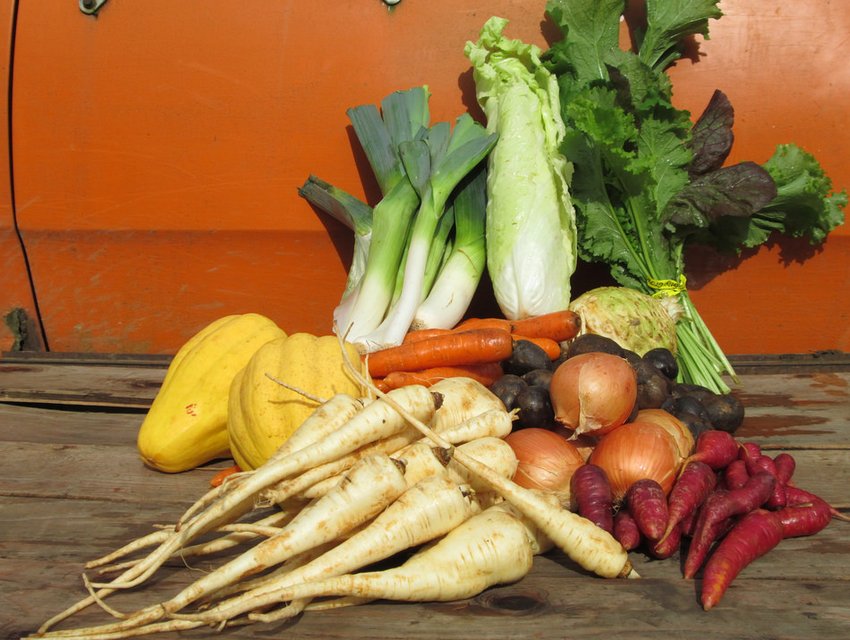| Carrots, mix | 6 lbs |
| Celeriac, prinz | 1 each |
| Chicory, pan di zucchero | 1 each |
| Leeks | 6 each |
| Mustard | 1 bunch |
| Onions, copra | 5 each |
| Parsnips | 5 lbs |
| Potatoes, purple majesty | 5 lbs |
| Winter Squash, thelma sanders | 2 each |
Crop Notes
Carrots, mix: The dark red carrots in your share are wonderful cooked. When slow cooked whole and unpeeled in stews the interiors become a deep orange reminiscent of sweet potato. The others are delicious to eat raw or grated into salads.
Celeriac: Don’t be intimidated by its odd appearance…also known as celery root, you can eat it either raw or cooked. Start by trimming of the top and the knobby roots so you have a flat top and bottom. Next trim the sides, removing the rough outer skin to reveal the white flesh beneath- and dont discard those peels! They add great depth and flavor to stock. Its wonderful savory flavor is great in stocks, stews, soups, casseroles and just about any other hearty winter creation. Celeriac pairs very well with potatoes- so you can include it alongside them in gratins, mashes, hash, etc…celeriac does take a little longer than potatoes to cook, so start the celeriac first or cut it into smaller pieces to compensate. We enjoyed this Thanksgiving slaw made by one of our crew member’s mom: mayo or yogurt, grainy mustard, white vinegar, salt and pepper to taste over a combination of cabbage, carrot, and grated celeriac.
Chicory, Pan di Zucchero: The name means ‘sugarloaf’ in Italian and its in the chicory family along with radicchio. This upright, green chicory is far more mild and sweet than its sibling radicchio. It will store for incredibly long periods of time in a plastic bag in the fridge, so you can cut a wedge off and put the rest back for later. You can eat Pan di Zucchero raw- shredded and dressed with a light vinaigrette, or cooked for a sweeter and more savory flavor. We recommend a quick, hot fry to quickly sear and caramelize the edges rather than a slower sauté, which will just wilt it without the browning.
Mustard Greens: These colorful bunches came out of our greenhouse, which feels a lot like the tropics these days. We seeded a mixture of Green Wave and Red Giant mustards, which are two of our favorite broad-leaf mustards. They are somewhat spicy raw- and are great on sandwiches. When cooked, mustard greens lose their kick and become very mild. Mustards are far more delicate than kales or chard, so a very light steam or sautee right at the end of preparing a meal works best. They take less than a minute to wilt down.
Parsnips: Related to carrot and parsley, this root vegetable has been cultivated since ancient times, it was even used as a sweetener in Europe before the arrival of cane sugar, and came to the United States in the 1800′s. Parsnips have a great combination of earthiness and sweetness, so you can either prepare them in a sweet or savory recipe, or both! Think roasted parsnips with cayenne and bacon, or glazed with butter and brown sugar.
Potatoes, Purple Majesty: This is the darkest purple potato available, inside and out. It will hold its lovely, fun color through cooking and makes one of the best-looking pots of mashed potatoes you’ll ever find. Not only do these spuds look great, they pack about twice as much Anthocyanidins (most widely know for their antioxidant properties) as any other produce, putting these right at the top of the list for ‘superfoods’. The skins on this variety oftentimes exhibit ‘russeting’, giving them a golden/tan sheen that is perfectly normal and edible.
Winter Squash, Thelma Sanders Sweet Potato Squash: It looks like an albino acorn, and was one of our taste-test winners! A great size for dinner, with a creamy, silky texture and excellent flavor. According the the Seed Savers Exchange website, this variety is a Family heirloom from Thelma Sanders in Adair County, Missouri. The seed was passed from neighbor Everett Pettit to Sue and Tom Knoche, Ohio squash collectors and two of SSE’s earliest members.

